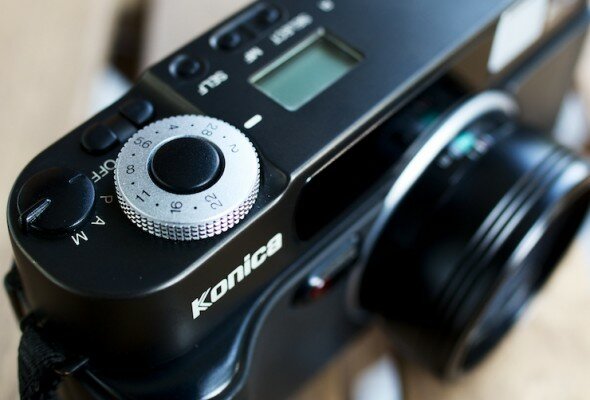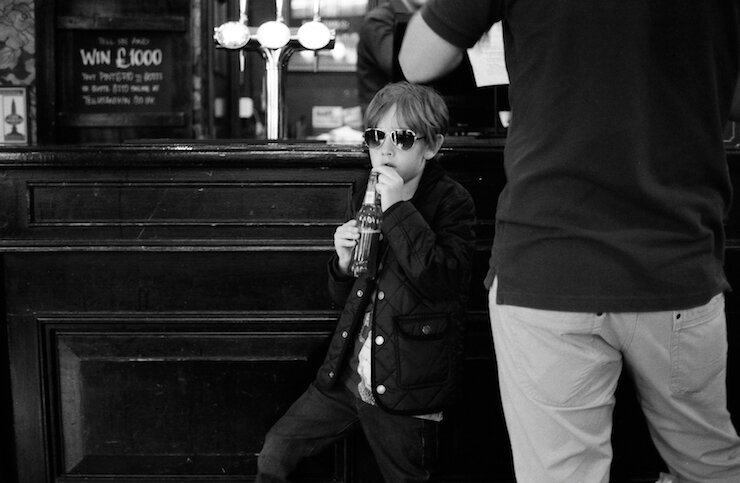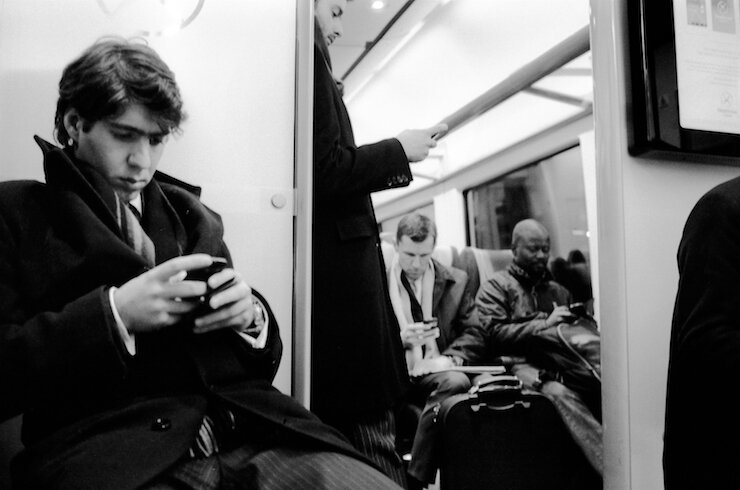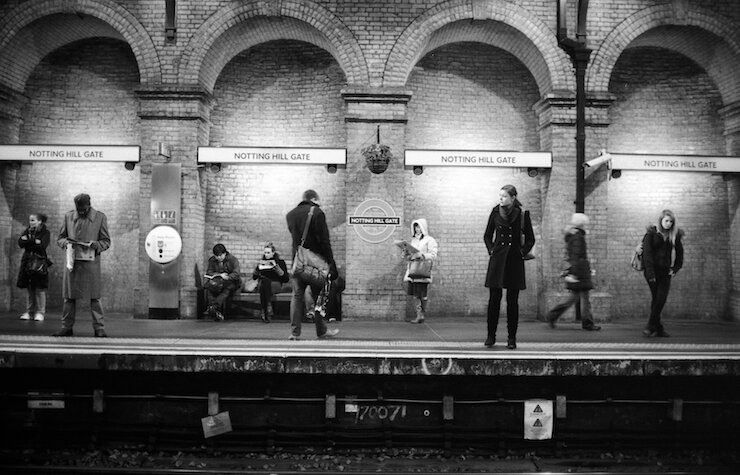
The term compact camera often has a condescending ring to it, as most compact cameras don’t live up to premium expectations. In the 1990s, when film photography was still a mass market for professionals and consumers alike, a number of Japanese manufacturers – many of them not in the photography business anymore today – swarmed the market with a range of outstanding premium compact cameras, some of them still in production today. Contax had the widest range with the most popular being the T2 and T3 models, Ricoh’s GR range is legend and continued with digital offspring, and Fujifilm is still in the game with their Klasse S and Klasse W models which are targeted at only the Japanese market. And then there is Konica with their Konica Hexar AF which entered the Japanese market in 1993 at a price point equivalent to more than US$1500 in today’s dollars. The Hexar AF sticks out in this list of premium compact cameras as it’s not really compact in size first of all and it seems to be a compact camera by specification only, more aspiring to be a rangefinder camera in disguise. Often referred to as the alternative to a Leica M6 with a Leica 35mm Summicron, the Konica Hexar AF has become a legend for being the perfect camera to attack the streets in style. Let’s see why and how well it fares from my point of view.
Personally, I don’t think gear reviews which focus on lab charts, photographing brick walls to illustrate lens distortion and counting pixels have any relevance for how I use that gear and what results I get from it. In this spirit, this review will focus on aspects of using this camera what it was meant for – real pictures in the real world and remarks on usability. All images shown in this review are taken with the Konica Hexar AF – except the image showing the camera itself obviously – and scanned with an Epson V350 scanner. Obviously, unless negatives (or slides) are scanned elaborately (and at great expense) with a drumroll scanner, the scans do not equal the actual sharpness and overall image quality of the actual frame. For online presentations, the scans are good enough though.
In a nutshell
There are lots of reviews on the Konica Hexar AF already, providing you all the technical specification details, so let’s take a look at just those details that matter. The Konica Hexar AF is by specification a point and shoot camera with a fixed focal length of 35mm, a f/2 maximum aperture lens and uses an active, infrared beam for auto-focus. The camera features a big, bright viewfinder which is parallax corrected and positioned in the upper left corner of the body to offer a rangefinder like experience. The Hexar has a Program mode, an Aperture priority mode and a manual mode with spot metering. Metering is not TTL, right of the lens is the IR beam emitter and sensor as well as the meter – don’t cover these with your hands when shooting. Film transport is automatic and by default very very quiet already – when engaging a special “silent mode”, film transport and shutter release are not audible at all, not even for the photographer holding the camera close to their ear! It’s this trait along with the excellent image quality of the super sharp f/2 lens that earns this camera a devote fellowship of fans. The camera features a maximum shutter speed of 1/250s which is probably why the lens closes down all the way to f/22. Operation is mostly characterized as automatic with manual operation via electronic buttons and the top plate LCD display.

London, UK. May 2013. With the Hexar AF, you will always be ready to capture moments like this.
General ergonomics
For a point and shoot camera, the Hexar AF seems unnecessarily large and in size it compares well to what is most likely it’s targeted competitor – the Leica M6 with the Leica Summicron 35mm lens attached. Both cameras are more or less the same size but the Hexar AF features a grip which makes it easy and convenient to hold even with one hand. It’s trivial to operate the Hexar AF with one hand – if it’s the right hand. The build quality is excellent. Even though the outside of the camera features a lot of plastic and rubber, the camera’s weight provides it with the right amount of hefty feeling – unlike those newer Fuji X100 digital copies of this classic camera which feel cheap and inferior due to their lack in proper heft. The Hexar AF has just the right amount of heft to feel solid and comfortable at the same time.
In operation, the camera is mostly automatic, like almost all point and shoot cameras, including exposure metering, auto-focus, film advance and rewind. Loading film is as easy and quick as it can be on any film camera, just insert the film into the camera, pull out the film just enough inside the camera and close the back, the camera will then transport the film to frame 1 and you’re ready to go. Film rewind is fast (unless the camera is operated in “silent mode”) and can be triggered with a pin using a dedicated button if necessary mid-roll.

Hamburg Hauptbahnhof, Germany. 2012.
For a fully automatic, auto-focus film camera, the Hexar AF does pretty good on battery life. It uses standard 6V 2CR5 batteries as you an get them easily in stores and online. I am still on my first battery after a couple of months and at times I have used this camera extensively. I can’t tell exactly how many rolls of 36 frames you can expose, but battery life certainly is not a complaint with this camera. Just take an extra battery on any trip you’re taking and you should be good for a very long time, not worrying about battery life.
The Konica Hexar Lens, 35mm, f/2
The 35mm, f/2 maximum aperture lens on the Hexar AF can compete with a Leica 35mm Summicron f/2 lens in terms of image quality – starting at f/2. If you need a reason to own a Konica Hexar AF, then it’s the lens and its image quality. You can get a Konica Hexar AF at a considerably lower price than a Leica 35mm Summicron. Jokingly, you can argue that by buying the Konica Hexar Lens you get a free camera as a fixed body cap along with it.
This lens was designed to be shot wide open with excellent results for sharpness, falloff and lack of vignette effects and this superb image quality becomes apparent in your images readily. If you ever marveled at that “3D effect” that many images shot with expensive Leica lenses possess, the Hexar AF will match this image quality and “pop” and provide you with the means to get there more conveniently. It’s safe to say that you will probably never own a much better 35mm focal length lens than the one that comes with the Hexar AF. What’s even more important and often neglected in reviews and gear considerations is how to take advantage of a lens that demands to be shot wide open. With f/2 at a focal length of 35mm and focus distances around 2 to 5 meters, depth of field is somewhere around 40cm and 2.6m. Using a manual focus rangefinder camera like a Leica M6 with a Leica 35mm Summicron lens, it’s sometimes not easy to focus fast enough and precisely enough to nail focus – especially in situations where there is less light – earlier or later into the day or inside of rooms. With the Hexar AF, this is something you don’t need to worry about. If you have an unobstructed line of sight to your target object, you can nail focus on it precisely, blazingly fast and quietly, no matter how much or little light is actually available. This makes f/2 usable in more situations than with many other cameras.

Paris, France. May 2013.
The lens features a permanently attached, retractable metal lens hood which still allows the use of thread filters. The lens accepts 46mm thread filters. Be aware that metering is not through the lens. With some filters you might want to compensate exposure values manually to account for the loss of light by using that filter.
The viewfinder
The viewfinder is big, bright and accurate. I am not 100% sure on this, but the viewfinder seems to be magnified at a factor of 0.7 which works well enough for 35mm, considering that the 35mm frame lines fill almost the entirety of the viewfinder. Even with glasses, the outer edge of the viewfinder is still visible so you can keep track of what’s happening just outside of the edge of your frame. A Leica M6 with the default viewfinder magnification at a factor of 0.72 dedicates the outer frame to the 28mm focal length with the 35mm frame lines already losing a lot of real estate of the actual viewfinder so that you end up with a higher magnification for 35mm in the Hexar AF compared to the default M6.

Seattle, February 2013.
The frame lines are clearly visible in most lighting situations but can’t compete with better viewfinders found in Leica’s rangefinder cameras for contrast and clarity. The Hexar AF’s viewfinder features parallax correction and you can see the frame lines adjust as you focus on something. In the top right corner, the upper right edge of the frame lines indicates on a rough distance scale what distance got measured by the IR beam (from 0.6 meters to infinity). This also works when setting the focus distance manually.
A bright green LED will confirm auto-focus and +/- LED symbols in the viewfinder will indicate over- or underexposure. You won’t see the detailed focusing distance, shutter speed or aperture in the viewfinder. To see the shutter speed measured for a frame by the meter, you need to keep holding the shutter button half pressed and peek at the LCD screen. That’s a bit annoying when you come from something like a Minolta XD7/11 or Minolta CLE, where shutter speeds are displayed through a LED panel in the viewfinder using Aperture priority mode.

Las Vegas Convention Center, Cab drivers protest. April 2013.
Compared to other premium compact cameras, the Hexar AF viewfinder is superior without a doubt. Using the Hexar AF to frame a scene is a very enjoyable experience and looking through the viewfinder for longer periods of time is not at all tiring.
Setting the focus distance
I have a love/hate relationship with focusing the Hexar AF. Its auto-focus uses an intelligent, two phase active infrared beam, emitted from the front of the camera. Essentially this means that unlike even modern digital cameras, the auto-focus is blazingly fast even in pitch black, dark rooms or at night. When the IR beam doesn’t make it back to the camera, the camera sets the focus distance to the lens’ hyper-focal distance at 20m (f/2). The lens barrel features a small viewfinder window indicating the measured (or set) focus distance. In auto-focus mode, when not pressing the shutter button, the camera resets the lens focus to infinity and shows a green AF symbol when reset. In manual focus mode, the set focus distance is shown and the lens is fixed at this focus point until set to a different position manually or by turning to auto-focus again. That way, in manual focus mode and by using the aperture dial, you can set the lens to hyper-focal distance and facilitate zone focusing.
Active IR based auto-focus has one considerable disadvantage: infrared beams cannot travel through glass (and other transparent surfaces). Whenever you want to take a picture of something (or someone) through a reflective surface – a situation quite common in street photography – the auto-focus misinterprets and the camera focusses on the measured distance to the surface that bounced off the IR beam back to the camera. In these situations you need to set the camera to manual focus – a task that is fiddly and cannot be performed quickly and precise enough in most situations. You need to hold the tiny MF button, and use the unmarked buttons in front of the aperture dial to set the desired focus distance. The steps in which you can adjust manual focus start small at 0.1 meters up to 2 meters distance, then increase quickly, so that setting an exact distance manually is not really possible. Best usage of this feature is probably for zone focusing using an appropriate aperture along the desired distance to have enough depth of field around the intended focus distance. To accomplish this, photographers usually rely on a distance scale on the focus ring of the lens with markings for depth of field zones for various apertures. The Hexar AF lens does not have such a scale, so you either need to memorize the math in your head for the 35mm focal length or carry some sort of table (or smart phone app) with you to help you.

London. January 2013. – Auto-focus against the window, I made sure the aperture choice
set for this shot allowed for enough depth of field which was easy as she was close enough to the window.
To summarize, it’s probably best to stick to auto-focus with this camera. Even though the intended use and the image quality of this camera can easily compete with a Leica M6 and a Summicron 35mm lens, these two cameras couldn’t be further apart from each other in the way they are best meant to be operated when it comes to setting the focus distance. The classic rangefinder is doing better in situations where the active IR auto-focus of the Hexar AF will be misled in complex focusing situations, while the Hexar AF will kick the s**t out of almost every camera out there – including all modern, digital auto-focus cameras – when it comes to setting the correct auto-focus distance blazingly fast and reliable on an object with a clear line of sight without any transparent surfaces in between the camera and the target object in any lighting situation. For comparison, even in a dimly lit room, the Hexar AF beats my Olympus OM-D E-M5 consistently for fastest and most reliable auto-focus.

London, UK. Shot through a glass window, manual focus with estimated distance and f/2.
Setting the exposure
In Program mode (P), the camera is fully automatic and there is not much a photographer can mess up when taking a picture. Use the viewfinder to frame your shot, half-press the shutter for focus and exposure metering, optionally recompose your frame while holding the shutter button and expose. That’s it. However, being the premium camera the Hexar AF is, you still have considerable artistic control over the frame you are creating as the Hexar AF will try to honor the aperture setting you dialed in on the top plate control wheel if that’s possible within the limits of the metered frame, the ISO of the film and the available shutter speeds the camera can handle. The camera will only deviate from your set aperture to honor a correctly metered exposure. In Program and Aperture priority (A) mode, the meter is center weighted and covers an angle of view of 15 degrees. For comparison, at 35mm focal length and with the viewfinder mostly matching what the lens “sees”, the frame you see through the viewfinder covers a little more than 55 degrees. In Manual (M) mode, the meter turns to spot metering, covering 4 degrees around the center of the frame. The spot meter in manual mode is more sensitive to higher light levels, by two stops exactly at the expense of losing three stops of sensitivity to lower light levels. While I have been using the camera in the last couple of months, I have used it almost exclusively in P and A mode, almost never in M mode.

Paris, France. May 2013. The center weighted meter of the Hexar AF handles backlighting situations well.
You can correct the EV for an exposure using the top plate buttons to dial in an EV correction in +/- 0.3EV steps. This is anything else but convenient and one of the few things that can slow down operation of this camera, say compared to any other camera which has a dedicated EV correction dial. After turning on the camera, you need to use the “Select” button to change the mode on the LCD screen, switching from displaying the exposed frames to EV correction. Then you can use the two unmarked buttons in front of the aperture dial to increase or decrease the EV correction in 0.3 EV steps.
Silent Mode

London. January 2013. Only a discreet and quiet camera can capture a scene like this.
The electronic leaf shutter, combined with the lens construction, is virtually silent. Even without engaging the “silent mode”, operation of the camera is very discreet, although the auto-focus on the lens and the film transport leave an audible signature in quiet environments. Turning on the “silent mode” makes this camera a very stealthy tool to record your environment unnoticed, the auto-focus is almost completely without noise and film transport quieter than a whisper. In some occasions I had to put my ear directly to the camera when taking a picture to actually have any sort of feedback other than checking the LCD screen that the exposure happened! Please note that the camera operates quietly only with a film in its chamber. If you intend to test a Hexar AF for its quiet mode, an empty Hexar AF will be considerably noisier than one with film. Every Hexar AF model has the “silent mode” to my knowledge, though some models have been delivered with this feature turned off in its firmware, most likely for legal reasons around patents. You can enable it on these models after the fact with a minor risk of “bricking” the camera if you make mistakes putting in the instruction set through the camera controls for enabling “silent mode” on these cameras. If you don’t want to take this risk, just go for the original, black Hexar AF which always comes with “Silent Mode”.

Paris, France. May 2013. Is the Hexar AF quiet enough for a bookstore or library? Yes!!
Turn on “Silent Mode” by turning off the camera, holding the “MF” button pressed while turning on the camera, putting it either P, A or M mode. The LCD display will now show a “L” in front of the number of exposed frames – on a fresh roll of film it will look like this: L[ 0].
“Silent Mode” makes the camera almost inaudible, but it also slows it down. Film transport will be slower, there is a considerable delay of your ability to quickly shoot the next frame and the auto-focus mechanism moving the lens elements in position will also be somewhat slower. Also, when the film has reached the last frame in “Silent Mode”, rewinding the film happens silently and slowly, costing you seconds more than not being in “Silent Mode”. My suggestion is to use “Silent Mode” only when it’s really necessary. I found that on the streets, the camera is already discreet enough without “Silent Mode” enabled. If you need to rewind your film fast while using “Silent Mode”, turn the camera off and on again just before the last frame, as this will reset the camera to normal operation.
Flash / Konica HX-14 Auto
I am an avid available light practitioner, so I am probably the least qualified person to review the use of flash on any camera. As I got my Hexar AF along with a mint Konica HX-14 Auto flash unit, I will comment on what I think about it from the point of view of someone who resorts to flash as a means of last resort and mostly infrequently.
The HX-14 Auto is a tiny pocket flash unit that is powered by two standard AA batteries and has a guide number of 14 at ISO 100. It supports both P and A mode with dedicated settings and a neat table on the back explains how to set the aperture for ISO 100 and 400 and what distance is covered as a result.
Ergonomically, the flash unit is small enough to just fit in a jeans pocket – if your jeans is not too tight that is. It blocks a little of the LCD screen when attached and with thick, clumsy fingers, the Select button might not be easy to reach, so usability of the camera is a little decreased but not much. The HX-14 Auto is easy to use and you can get correctly exposed images without a hassle using this tiny little flash unit.
You can also use the HX-14 Auto with remote flash cords such as the Nikon SC-17 although there are probably better options available. I just happened to have one of those waiting in the closet readily available to test the HX-14 Auto as an off camera flash unit – not that I would ever seriously consider changing my street photography style to in-your-face Bruce Guilden type of photography. Not with such an elegant, stealthy and quiet tool as the Hexar AF anyway!
I might give the HX-14 Auto and the SC-17 a more elaborate try for portraits as I can’t imagine frequent use of on camera, frontal flash.
What the Konica Hexar AF does very well
After using this camera for several months, the camera traveling alongside me to various international destinations and exposing at least 30 to 50 rolls of film with this camera, the Konica Hexar AF scores on these accounts for me:
- It’s super easy to operate, even with only one hand available.
- The camera is very discreet in shape and size, it hardly attracts attention, especially the black version is very stealthy.
- It’s the quietest 35mm camera ever, being virtually without audible noises when exposing in “silent mode”.
- The metering is precise and reliable and with the Hexar AF’s ability to easily shoot sharp images at f/2, the camera is a great choice for slower slide films, especially when shooting in daylight.
On the street, especially within buildings, public transportation facilities and vehicles etc., I can hardly imagine any other camera better suited to stealthily capture quiet moments in low light at open apertures.

London. January 2013. The 35mm focal length of the Hexar AF helps capture a lot of context.
The question which focal length is best for street and documentary photography is often a religious one and certainly a very personal preference for most photographers. While personally, I prefer to shoot most of my work at longer focal lengths, if I only had one camera with one lens attached for a trip around the world in 80 days or such, I would pick the Konica Hexar AF for the versatility of its 35mm focal length. It’s wide enough to cover context and scenery and still narrow enough to get in close and personal for portraits without distorting features of the image.
Also, the Konica Hexar AF can be operated quicker and with drawing less attention even than using a classic rangefinder camera like a Leica M type.
Where the Konica Hexar AF falls short
The Konica Hexar AF is a camera that specializes on specific photographic situations in my point of view and does very well for what it was obviously designed, knowingly missing the mark where its design contradicts use outside of its specifications and intended purpose.
- A maximum shutter speed of 1/250s forbids any type of action photography, freezing motion that exceeds 1/250s. This makes the Konica Hexar AF a camera for the quiet moment. It also affects choice of film and film speed, as higher film speeds – most at all during daylight times – demand faster shutter speeds, depending on the environment.
- The Hexar AF’s dependency on its auto-focus and awkward manual overrides put it at a big disadvantage where (fast) manual operation is required. The Hexar AF is for that reason not the ideal camera for landscape photography, as the auto-focus never sets the lens to infinity and there is no way to remotely trigger the shutter.
- Unless using zone focusing, the Konica Hexar AF fails in situations where transparent surfaces irritate the intended function of the auto-focus. In those situations, manual focus cameras with a SLR split prism viewfinder or rangefinder are more suitable.

Seattle in the early morning. April 2013. Tripod, camera set to MF and infinity focus, f/11.
Verdict
The Konica Hexar AF is a winner. If the 35mm focal length is your cup of tea and your style of photography falls roughly into portrait, documentary or street photography, this camera should be in your possession even if you already own a separate 35mm focal length setup. Why? Let’s face it – whatever other 35mm focal length setup you already own, it won’t be able to compete with the Konica Hexar AF in terms of stealthy, quiet, precise and fast operation at low apertures with excellent results. That’s the Hexar AF’s raison d’être and main design principle and makes it the ultimate tool for quiet moments.
Don’t take my word for it – read what others have to say about this camera
The Konica Hexar AF has a devote fan base. I found these reviews very helpful: Konica Hexar AF at Photo.net by Richard Caruana, Cameraquest, Johan Niels Kuiper, Dante Stella, Matt Alofs, Japan Camera Hunter and Billy Baque. Not to be taken too seriously, but very entertaining is this shootout of a Konica Hexar AF versus a Leica M9 with a 35mm Summicron Aspherical on Youtube.
Who is using a Konica Hexar AF?
Not that it matters what other people use, but it’s always nice to see a gadget you’re fond of endorsed by others. You would expect the Konica Hexar AF to be the weapon of choice to attack the streets and indeed that’s the case for both David Solomons and Jesse Marlow, both of In Public fame. Annie Leibovitz has also been spotted sporting a Konica Hexar AF. If it’s good enough for Annie, it should be good enough for you!
October 6th, 2013at 15:16(#)
Great article! I purchased a Hexar AF not too long ago. It was the first of four film cameras I purchased since getting back into film. To be honest, until now it hasn’t had much use since I usually tend to grab my Contax T2, but your article has definitely motivated me to pick it up and hit the streets again.
Just one question, which film did you use?
Thanks a lot!
October 26th, 2013at 21:41(#)
Hi, thanks for commenting.
The black and white films I use are Kodak BW400CN (a C41 based film) and Kodak TRI-X 400. The colour films vary, I rarely use expensive Kodak branded film on a daily basis. Sometimes I use Agfa slide film, but mostly it’s unbranded Kodak or Fuji film from discounters. I prefer black & white by now for film photography.
December 6th, 2013at 18:59(#)
Hello!
I’ve got one of these lying around that my parents used back in the 90’s, however, it seems to need a new battery. Do you have any knowledge or tips on where to find such things?
Great article!
Thanks.
December 6th, 2013at 19:03(#)
Oh, nevermind. Figured it out!
Thanks anyway!
December 8th, 2013at 17:25(#)
Hi Alice,
these batteries are pretty common still. You should be able to get them at supermarkets even, that’s where I got mine. Other than that, there’s always a matching Panasonic battery that can be ordered via Amazon or others online.
Have fun using it, it’s an awesome camera!
Tobias
February 3rd, 2014at 18:41(#)
I just got this camera a few weeks ago and am absolutley loving it! Do you have an online gallery anywhere of just your Hexar shots?
February 19th, 2014at 22:37(#)
Hi Kyle,
Sorry for the late response. You can take a look here:
http://www.flickr.com/photos/polarapfel/sets/72157633943724796/ Most of these were taken with the Hexar.
http://www.flickr.com/photos/polarapfel/sets/72157634070917384/ All of these were taken with the Hexar.
Have fun with yours! You can ping me on Flickr when you have shots to share from yours!
Tobias
February 25th, 2014at 05:25(#)
[…] […]
July 15th, 2014at 13:16(#)
Amazing that this little gem is getting a “revival” in 2013/14.
This is my most recent acquisition. I love the handling of the camera.
The simplisticity of the camera controls (or the rudimentary.spartanic functionalism) reminds my of the Ricoh GR Digital III (which is still my favourite digital shooter).
Yes yes it doesn’t feel like anything of my “real” Leica rangefinders, but I sense that I will be enjoying this camera the most, but my hands cramp up holding the Leicas and even the Bessa with the handgrip. Not so with the Hexar.
Only wish is that the it’s viewfinder to have a slightly brighter viewfinder and framelines.
September 7th, 2014at 20:57(#)
I love your review which is very informative. I also have to agree with your comment of Bruce Guilden’s style If you care to be instagram buddy, my insta account is wonderlandproject
If you care to be instagram buddy, my insta account is wonderlandproject
January 9th, 2015at 17:33(#)
[…] especially for low light situations I bought a Hexar AF. The one with the SILENT STEALTH MODE. And here you can read an amazing review of the Hexar AF. No Leica can beat the stealth mode of the Hexar […]
May 14th, 2015at 10:12(#)
“The Hexar AF is for that reason not the ideal camera for landscape photography, as the auto-focus never sets the lens to infinity and there is no way to remotely trigger the shutter.”
I think you are missing out on a feature. You can quickly set the lens to infinity by simply pressing the MF button. This sets the lens into infinity and it will stay there until you take your shot.
It is true that you cannot remotely trigger the shutter, but you have a self timer.
So for landscape photography with a tripod, simply compose, then press MF, then press the SELF button—10 seconds later you will have your shot without any camera movement and at infinity. That’s what I will do on my next landscape photo shoot 😉
June 25th, 2015at 15:52(#)
Love the review of the camera! I just got one the other day and had a question. When the camera is turned off and you hold the select button and switch the camera to ‘A’ mode the screen has p11 on it. What does p11 stand for? You’re able to adjust the numbers up and down (p13, p14, p16 etc)
July 6th, 2015at 20:33(#)
Enjoyed the article, very clear. Found mine twenty years ago and has been a keeper. My other kit is a Nikon F2 with plain prism and 50mm, 105mm.
August 12th, 2015at 10:38(#)
Jarod, that’s new to me. I’ll try to find out. Thanks for the hint.
January 4th, 2016at 00:01(#)
dear mr./mrs. webmaster,
pls update the link to my website at the bottom of this very nice article to the new and current url: http://www.johanniels.com/index.php/camera-gear-articles/27-konica-hexar-af-the-ultimate-compact-camera so people get to the right page straight away!
And a Happy New Year too!
cheers from Johan Niels